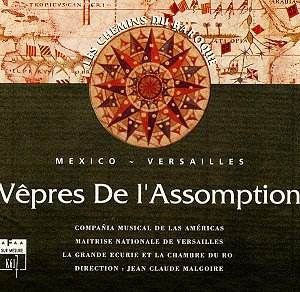|
|
Search MusicWeb Here |
|
 |
||
|
Founder:
Len Mullenger (1942-2025) Editor
in Chief:John Quinn
|
|
|
Search MusicWeb Here |
|
 |
||
|
Founder:
Len Mullenger (1942-2025) Editor
in Chief:John Quinn
|
 |
VÊPRES DE L'ASSOMPTION
1. Intonation "Deus in Adjutorium" Responsory "Domine in Adjuvandum Anon, Bogota 1701 2. Antiphon "Assumpta est Maria" Psalm 109 "Dixit Dominus" Juan de Araujo 3. Kyrie I & III M-A Charpentier (separated by Psalm 112 Laudate pueri in fauxbourdon) 4. Antiphon "In odorem uniguentorum Psalm 121 "Laetatus sum / Kyrie V Manuel de Sumaya 5. Antiphon "Benedicta Filia" Psalm 126 "Nisi Dominus M-A Charpentier 6. Psalm 147 "Lauda Jerusalem" Manuel de Sumaya 7. Kyrie / Ave Maris Stella / Offertoire M-A Charpentier 8. Antiphon "Hodie Maria virgo" Magnificat M-A Charpentier Maîtrise Nationale de Versailles (prepared by Olivier Schneebeli) La Grande Ecurie et la Chambre du Roy Conducted by Jean-Claude Malgoire Recordings made in the church of Tavira, Portugal on 31 May - 3 June 1992. |
| CD available for post-free online mail-order or you may download individual tracks. For some labels you can download the entire CD with a single click and make HUGE savings. The price you see is the price you pay! The full booklet notes are available on-line. | |
|
NOTE • Click on the button and you can buy the disc or read the booklet details • You can also access each track which you may then sample or down load. • Further Information. |
|
|
The choirs performing this disc are also of interest. The Maîtrise Nationale de Versailles is an on-going project to spearhead a revival of choir-schools in France and it maintains something along the lines of an English collegiate choir school, maintaining 26 boys who study general subjects in the morning, music in the afternoon, and perform weekly in the Royal Chapel at Versailles. The Compañia Musical de las Americas is even newer, being formed of Mexican singers specifically for this recording project, with a view to assisting in the preservation of the vast riches of the Spanish American baroque repertoire. The sound of both choirs is less refined than one would expect of longer established professional groups, but is in no way as obtrusively unpleasant as some other choirs in this same K617 Chemins de Baroque series. The disc is also aided hugely by the presence of both the conductor Jean-Claude Malgoire and the players of La Grande Ecurie et la Chambre du Roy. Malgoire keeps the proceedings moving with style and elegance and the importance of instrumental parts in some of the Charpentier certainly needs the experienced players employed. The quality of the string playing is evident in the Psalm Laetatus sum by de Sumaya (sample 1) and throughout remains crisp and well tuned. The finest work on the disc is the double choir Magnificat by Marc-Antoine Charpentier. Having spent most of his career in the service of the Jesuits, Charpentier understood the concept of sumptuousness that lay at the heart of the counter-reformation and this Magnificat is filled with theatrical effects and wonderfully dense writing with taut structural features apparent throughout. (sample 2) Charpentiers activity as a composer of instrumental music is not widely appreciated as he wrote very few free-standing instrumental works. However, this recording makes use of instrumental interludes drawn from his "Mass for several instruments instead of organs." The offertory that precedes the Magnificat is a fine example, somewhat reminiscent of the ensemble canzonas of Gabrieli, and the cornetto and violin dialogues are brought across well. Again the impression is one of sumptuous richness. (sample 3) This is a very enjoyable and well put together disc with good notes in a well presented booklet. a nice overall product. Peter Wells
|
| ADDITIONAL INFORMATION •
You can sample only 30 seconds (or 15% if that is longer) of a given track. Select from the View tracks list. Each sample will normally start from the beginning but you can drag the slider to any position before pressing play. • PLEASE NOTE: If you are behind a firewall and the sound is prematurely terminated you may need to register Ludwig as a trusted source with your firewall software.
•You will need Quicktime to hear sound samples. Get a free Quicktime download here • If you cannot see the "Sample All Tracks" button you need to download Flash from here.
|
|
|
Return to Index |